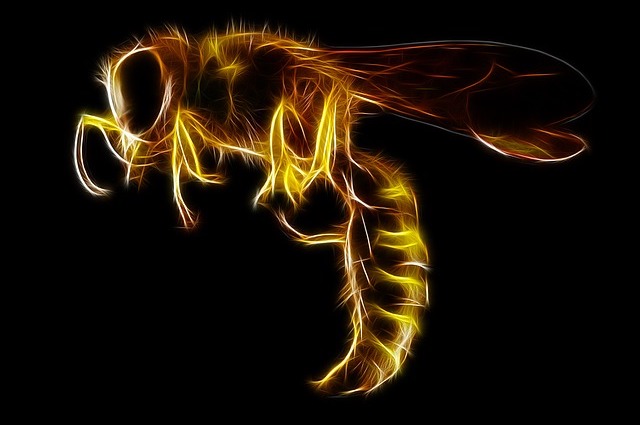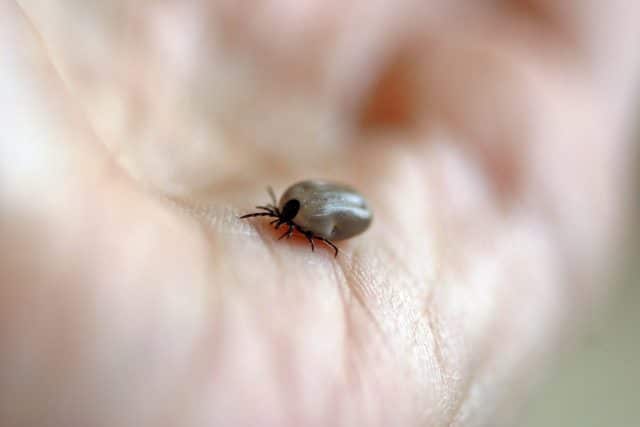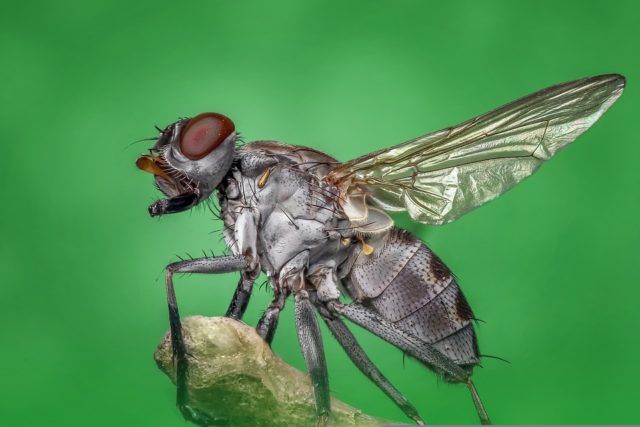Paleontologists love amber. Unlike sedimentary fossils, this fossilized coniferous tree resin preserves flora and fauna basically intact–often right down to the color. As creatures end up in amber by getting caught in free-flowing tree sap, many are frozen mid-action. They can even look like they’re alive.
Really, though, these are fossils too. Their flesh has broken down into carbon and, unlike in Jurassic Park, there’s no DNA left for cloning. They’re just more intricately detailed.
10. Fossil flower and parasitic wasp

In what has been called “an exquisite merger of art and science”, paleontologists discovered a new species of long-stemmed flowering plant complete with a new species of wasp. The fossil, encased in 30-million-year-old amber, was found in the Dominican Republic – where some of the clearest resins are seen.
Like the rubber tree, the plant belongs to the Euphorbiaceae family and has been named Plukenetia minima. It was in full bloom when the wasp appeared attracted to it. While many organisms are fossilized together by chance, it’s thought that the wasp had a purpose in mind in this case. One of the seed pods contains a fly larva and would therefore have been a good place for the wasp to lay an egg. Or it may have just landed for nectar.
Either way, it’s a fascinating – and beautiful – piece of amber.
9. An ant with a mite

An ant with a mite may not sound much, but this one in amber was a big deal for science. It was only the second discovery of a mite still attached to its host after fossilization – in this case 44-49 million years later.
The 0.7-millimeter mite clamped onto the ant’s head before the two were “trapped for eternity” by tree sap. Thought to belong to the genus (members of which are still around today), its position on the ant is also observed among modern Varroa mites thought responsible for bee colony collapse. It’s difficult to identify the exact species, however, because of an air bubble obscuring some features.
As you might imagine, ants are a common find in amber. Another discovery of 24 specimens from the mid-Cretaceous actually included nine new species.
8. Tick wrapped in silk

When, 100 million years ago, a tick got stuck in a spider’s web, it was swiftly wrapped up by the spider. But it wasn’t its fate to be eaten. Once it was wrapped, it was smothered by tree sap – preserving its corpse for eternity.
This became the first known fossil of a tick wrapped in spider silk. It’s rare enough to find fossils of ticks as it is. Although we know they were common in prehistory, fossils are apparently few. It’s also not that common for spiders to prey on ticks today. So this amber is a pretty big deal.
That said, it’s also possible the tick wasn’t being preyed on but was only wrapped in silk to immobilize it. It may later have been ejected from the web into a tree resin ooze.
7. Spider attacking a wasp

The first fossil evidence of spider sociality was discovered in Burmese amber, where two orb-weaver spiders – an adult and a juvenile – were living together in a web. To put this in perspective, it’s rare to find even living spiders in cohabitation.
But that’s not all. The younger male was engaged in what has been described as “a fight for the ages” – a spider attacking a wasp. Poised to pounce for the kill, the juvenile orb-weaver was engulfed by tree sap, along with the wasp, its web-mate, and some of the web as well.
This super rare encounter is thought to have taken place 97-110 million years ago in what is now the Hukawng Valley, Myanmar.
6. Mating flies

It’s not always antagonistic encounters preserved in amber for eternity. Sometimes it’s a little romance – albeit ended abruptly. This was the case for two long-legged flies who, 41 million years ago, found their coitus tragically interruptus’d by a drop of falling tree sap.
Unearthed on the southern coast of Victoria – which in the Late Middle Eocene was southern Gondwana – the find was hailed as “the first example of ‘frozen behavior’ in the fossil record of Australia”. It is possible, however, that what we see here is not the full story. As one paleontologist suggested, one fly may have become trapped in the amber before the other got excited and tried to mate.
Nevertheless, it’s an important discovery – especially given the majority of amber fossils come from the northern hemisphere.
5. Weird new insect
When a female insect from the mid-Cretaceous was found in Burmese amber, it was immediately obvious that this was an unknown species. Its head – an isosceles right-angle triangle – was unique. While many insects have triangular heads, never is the vertex at the base.
Not only does this species (Aethiocarenus burmanicus) have a downward-pointing triangle head, but it also has prominent eyes. With its long legs, slender body, and swollen abdomen, it kind of looks like an alien.
It’s so unusual, in fact, that it required its own new taxonomic order – Aethiocarenodea. This doesn’t happen often. The roughly one million insects we know of (living and extinct) all slot into 31 orders.
It’s thought it would have been able to see close to 180 degrees when it turned its head sideways, allowing it to see things behind it. This would have been useful in its niche, hunting (researchers think) mites and worms in the cracks of tree bark. It’s also thought that its long body and legs were used to repel predators, while glands on the neck secreted a toxin.
4. Microscopic mold pigs

Another discovery demanding its own new taxonomic family, genus, and species was a previously unknown microinvertebrate found in Dominican amber. At 100 micrometers, Sialomorpha dominicana is invisible to the naked eye. It’s like a tardigrade, or ‘water bear’, with eight legs, but it’s smaller and doesn’t have claws. For its “portly, porcine appearance,” and fungal diet, it’s affectionately known as a ‘mold pig’. Like tardigrades, it may have been extremely resilient – capable of surviving long-term freezing and even space travel.
The amber contained hundreds of specimens, which meant scientists could study the species in detail. For example, they found the heads were flexible, and the bodies grew by molting the exoskeleton. Since several other organisms – pseudoscorpions, nematode worms, fungi, and protozoa – were found in the same amber, we also know what other species the mold pig lived among.
It’s not known whether it has any living descendants.
3. Randy daddy longlegs

It’s rare to find any kind of courtship behavior preserved in the fossil record. One of the most unusual examples – discovered in Burmese amber – was a 99-million-year-old daddy longlegs with an erection. As Gizmodo noted, “It’s possibly the oldest–and longest-held–erection in the history of science.”
It’s doubly unusual because daddy longlegs, or harvestmen, are the only arachnids with a penis. While others use modified legs, the daddy longlegs delivers sperm through a very long phallus (half its body length) with a heart-shaped head and twisted tip.
It’s assumed the spider fell into tree resin while mating. But it could also have been going about its daily business when it was caught in the sap, its struggle to escape increasing its blood pressure and causing that erection.
2. Dinosaur feathers

We can understand very little about early feathers from looking at their flattened sedimentary fossils. Amber, on the other hand, preserves their true three-dimensional structure and even the colorful pigments – gray white, red, and brown. Some of the most diverse were found in western Canada and dated to the Mesozoic Era (which includes the Triassic, Jurassic, and Cretaceous).
In fact, so great is the detail that paleontologists have found feathers infested with lice. Ten individual specimens of the previously unknown species Mesophthirus engeli were discovered in two pieces of Burmese amber containing damaged dino feathers.
It’s well known that dinosaurs were parasitized by ticks and fleas, but these specimens – dated to the mid-Cretaceous (100 million years ago) – were 34 million years older than any yet encountered.
1. A whole bird

Creatures larger than insects are obviously rare in amber; they can easily escape from the sap. But specimens aren’t unheard of. For example, a new species of scorpion was found encased in amber in Mexico, and a 99-million-year-old lizard skull made headlines when reported in March 2020. With more than 100 teeth in its tiny jaws, as well as some weird-looking eyes, it was unlike any we know.
Paleontologists also found a bird in amber – a hatchling a few days old – that probably fell from its nest roughly 100 million years ago. “It’s the most complete and detailed” ever found, said Ryan McKellar of the Royal Saskatchewan Museum. It even had brown feathers. In fact, it had a complete set of flight feathers and some at the tail (unlike modern hatchlings of the same age). It’s thought to have got stuck in tree sap on its way up the trunk, probably having hatched on the ground.
Even more interestingly, the hatchling belonged to a broad taxonomic group called ‘opposite birds’. Characterized by socket-and-ball shoulder joints (instead of ball-and-socket, like modern birds), as well as claws on their wings and teeth instead of beaks, ‘opposite birds’ are thought to have been more diverse and successful than the ancestors of modern birds, alongside which they evolved.